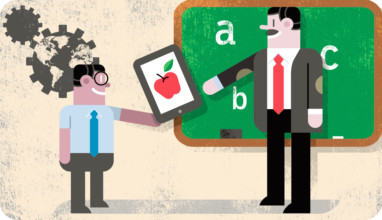
Most people have a very traditional conception of teaching. Ask a parent how she imagines her child in school, and she will describe a classroom with a teacher standing at the front, near a board (white, black, or green), and pupils (hopefully a small number) sitting at tables, one by one or two by two, row behind row, listening and writing. Ask a (typical) educator how teaching is best performed, and he may murmur something about “active” or “collaborative” learning, “technology and web tools”, and other such “innovative” approaches, but in reality, he will most likely be just lecturing to his students, trying to impart as much “knowledge” as possible.
This is what a recent study on creativity and innovation in education in the European Union reported: “Conventional ways of teaching, [i.e.] teacher-centred methods, frontal teaching and chalk-and-talk, prevail in a good majority of schools in the EU27.”
Indeed, despite countless documents and books promoting “novel” teaching methods, most teachers still resort to the old, traditional direct instruction and direct assessment (pen-and-paper exams checking how much “knowledge” was retained – temporarily). In truth, it is much easier to lecture than to engage one’s students, and easier to give traditional exams, which often come with the textbook, than to innovate in any regard. Teachers, starting with myself, have an unconscious tendency to stay with the old passive methods and to resist any push for more active methods of teaching and learning.
We have convinced ourselves that these methods do work (some students do get A’s, after all) and that they are efficient (other methods take so much time that through them we can’t finish the material). But study after study have shown that students learn in very different ways and come with a wide spectrum of abilities, that interactivity and engagement are fundamental to effective learning, especially at younger ages, and that today’s world offers new challenges — and new tools. The old approach is not only inefficient but obsolete.
In today’s world, the content of a course is not the key part of the teaching. At least it should not be. Why? Because much of the material we teach is accessible by just a few keystrokes, taps, or swipes. As I keep telling my students, we need to get rid of the tendency to store information in our brains when we all carry web-connected smartphones or tablets that can get us to Wikipedia (or better sources) in a few seconds. What we do need to develop is the ability to evaluate the information we access, to organise it, and to reconstruct it in a creative and insightful way. What we need is to develop more and more critical thinking, the ability to assess and judge facts and ideas in a world that breathes information – of hugely varying degrees of quality. In fact, the profusion of new and fast-increasing information has had another negative effect on education: Curricula are more and more overloaded. Worse yet, most of the content is required to be known and can be expected to appear in end-of-year exams.
Constant exchanges
Can a teacher then be expected to be creative and innovative in such conditions? Yes and No. Yes, because it has become clear that the old traditional methods are no longer effective, and indeed there are new tools that can help us teach effectively. No, because while teachers are expected to try new ideas, the effort should really be a concerted one, with constant exchanges among teachers, administrators, education experts, and parents on what works and what doesn’t. Teachers stay with the old teaching approach for several reasons: they don’t have time to try new things; they have large classes that do not lend themselves to anything but the lecture format; they have no incentive to innovate (parents and principals will only accept letter grades or number scores, no other “assessment”); and they lack the confidence, the training, and the resources to really be creative.
And yet there are a number of tools and methods that have proven to be successful in various situations: Collaborative (group) learning; inquiry-based learning (where students investigate an issue, collect data/information on it, formulate a hypothesis and check it, thus learning through the process); novel ways of “processing information” using graphs, charts, maps, and other ways to present and retain important facts; “constructivist learning”, where pupils learn by discovering things by themselves, under the hands-off supervision of the teacher/facilitator; etc.
What is needed is a paradigm shift among teachers and educators that this globalised, digitally connected, and fluid world needs new minds. Hence, our teaching must change to adapt to the new realities. Teachers need to be trained to teach in this new, more useful way. At minimum, the internet needs to be integrated into the education process, and not just as a repository of information that can be downloaded. Curriculums need to be revised, lightened, and made more interactive, dynamic, and relevant.
Our graduates will need to be creative and innovative in their future job environments; we teachers must show them that creativity and innovation begins in the classroom.
Nidhal Guessoum is a professor of physics and astronomy at the American University of Sharjah. You can follow him on Twitter at: www.twitter.com/@NidhalGuessoum.










